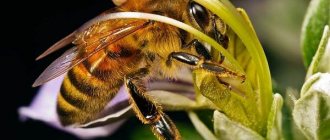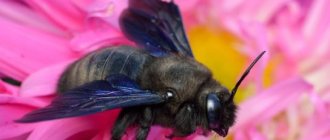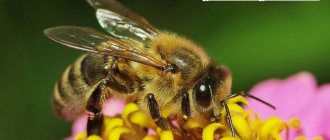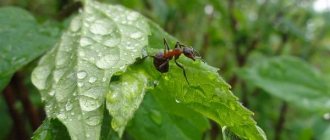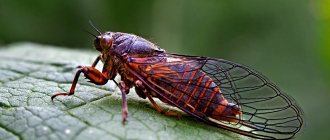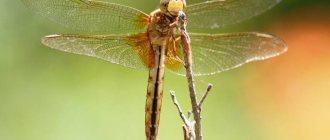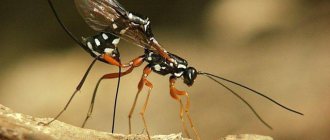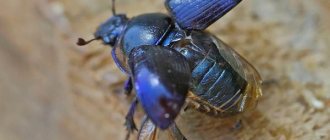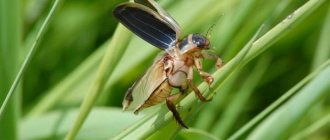- Where do bees live
Perhaps the bee is the most useful insect on our planet, because thanks to it, people have had the opportunity to enjoy honey since ancient times. Even in ancient times, people learned to specifically breed bees, and the honey obtained with their help has served for centuries as a favorite sweet treat, medicine, and an important ingredient in the creation of alcoholic drinks, such as mead, which was very popular even among our distant ancestors during the times of Kievan Rus. So, since ancient times, the bee has been a faithful friend of man and this is our article for today.
Description, structure, characteristics
According to the zoological classification, the bee belongs to the stinging family, the order Hymenoptera, and its closest relatives are wasps and ants.
The color of the bee is well known; it consists of a black background with yellow spots. But the size of a bee, depending on its type and class, can range from 3 to 45 mm.
The structure of an insect’s body can be divided into three parts:
Scientific classification
Bees have a long proboscis, which they use to suck pollen from plants. They also have antennae (or antennae)
,
siazhki
), each of which consists of 13 segments in males and 12 segments in females. All bees have two pairs of wings, the back pair being smaller in size than the front; only in a few species of one sex or caste the wings are very short, making the flight of the bee difficult or impossible.
Many species of bees are poorly studied. The size of bees ranges from 2.1 mm in the dwarf bee (Trigona minima) to 39 mm in the species Megachile pluto, found in Indonesia.
The name “bees” (Latin Anthophila) characterizes an entire group (section) of organisms that is part of the superfamily Apoidea of the order Hymenoptera (Latin Hymenoptera).
This section includes seven families, one of which is the family of real bees (lat. Apidae). Honey bees (lat. Apis mellifera L.) belong to this family.
Habitats
Bees live over a very wide geographic range, so it's easier to answer where bees don't live than where they do live. So, there are no bees only in those places where there are no flowering plants: hot sandy deserts and cold arctic tundras. In all other places there are bees.
As for the favorite habitats of these insects, they love to settle in mountain crevices, build their hives in the hollows of old trees and earthen burrows. It is important for bees that their habitat is protected from the winds and that there is a body of water nearby.
Honey bee: domestic or wild animal, insect?
Important: Bees can be domestic or wild.
Bees are considered domestic not because they can be kept like a pet cat or dog. Domestic animals also include animals that a person breeds for profit or benefit. By the way, in this case it is appropriate to say that bees are pets. This formulation is a common cliché.
But bees were originally wild. They lived in hollow trees and produced honey only for their own food. People have domesticated a large number of animals that are capable of producing food or providing assistance on the farm, including bees.
To do this, they began to set traps, and bees settled in them. People then moved the wild bee traps onto their property. The bees got used to their “house” and did not fly away. Currently, beekeepers use the same method to catch swarms of wild and stray bees.
Apiary - place of residence of domestic bees
But it is worth saying that bees have a biological feature - swarming. This means that bees fly away from the hive, even if they have been living there for a long time. This event happens in the spring, and an experienced beekeeper knows how to prevent bees from swarming. But if it happens that the bees do fly out of the hive, it is worth making attempts to bring them back. To do this, traps are set again.
When bees fly out of the hive, they do not scatter in a chaotic manner in search of a new place to live. The whole family sits on a bush or tree, and only a few scout bees fly in search of a good place. When the scouts find such a place, they return to the family. Then the entire bee family moves to a new place of residence.
Swarm of wild bees on a tree
Wild bees still exist in nature. They obtain nectar from wild honey plants. Basically, wild bees live in forests where humans have not yet reached. Domestic bees that escape from the hive can become wild if they are not caught by the beekeeper. They will organize a nest for themselves and a place to produce offspring.
Bees do not hibernate in winter. Low temperatures do not allow them to fly, nectar cannot be found in the cold season, so the bees gather in a club and thus overwinter. They always care about the future and make good reserves of honey for the winter. A dense and warm club helps to keep warm and keep the offspring alive.
Initially, there were no hives in the modern sense. Extraction of honey caused inconvenience to both the beekeeper and the bees. Scientific and technological progress has not bypassed this important industry. There are various designs of hives and other devices that do not cause inconvenience to bees.
Domestic bees
Even those bees that live in the apiary are capable of stinging. The beekeeper gets a lot of bites, despite the fact that he is the owner of the bees. This is the peculiarity of these insects. This way they are protected from potential threats. Although bees themselves are peaceful creatures. If you don't touch their home, they won't attack people. It’s a pity that self-defense comes at the cost of the bee’s own life. Once stung, a bee has no chance of survival. You can find out why a bee dies after being stung here.
Bees have unique abilities and interesting features. You can find out more interesting facts about bees in the video.
Lifestyle
Bees are collective insects that live in large families - hives - and have a strict hierarchy and division of labor. The composition of a bee family includes:
- uterus,
- drone,
- worker bee.
In bee society, matriarchy reigns and it is the females who are entirely responsible for ensuring the life of the hive, while the males, also known as drones, exist only to procreate.
The queen bee is the queen of the hive, it is she who is responsible for the reproduction of offspring, she is also the creator of the hive and at first is engaged in its arrangement, until in this matter she is replaced by the worker bees that are born.
The task of male bees, drones, is only one - to fertilize the queen.
The entire economic life of the hive rests with worker bees, female bees incapable of sexual reproduction. They are the ones who hardworkingly collect nectar from flowers, protect the hive in case of danger, arrange its arrangement, transport honey, etc.
Character and lifestyle
Bees are social insects with a highly organized life. Together they obtain food and water, protect and guard the hive. In any group there is a strict hierarchy in which each level performs certain functions. The number of individuals may vary; the more bees there are in a group, the more differences appear between representatives of different levels of the hierarchy. Each structure has a uterus.
In the photo there are bees and a queen bee
Representatives of some groups are solitary bees. This means that in a given species there is only one type of female, and each performs the same functions - collecting pollen and storing food, and also reproducing.
Most often, such species do not produce honey, but their function is different - they collect pollen and nectar only from their “favorite” plants, that is, if the bees die, then the plant will disappear.
Females of solitary bees, for example, a black insect similar to a bee (the carpenter bee), often lay eggs in one hole in order to take turns guarding it, this lifestyle is usually called “communal”. But, each bee cares and fills only its own cell.
Representatives of some families cannot obtain food for themselves due to the lack of special devices, so they are forced to take food and lay eggs in other people's hives. Bees belonging to this species are often called “cuckoo bees.”
Honey bees form huge families. Typically, a family includes one queen, several thousand working females, and in the summer also several thousand drones (males). Alone, they will not survive and will not be able to create a new family.
Lifespan
The lifespan of a bee directly depends on its place in bee society, as well as the time of birth.
How long does a worker bee live? Her lifespan is not long, and if she was born in spring or summer, it usually averages only a month. Such a short life expectancy is due to the hard work that the worker bee does to obtain nectar.
If a worker bee is lucky enough to be born in the fall, then she can live even six months, since she needs to survive the winter cold in order to be responsible for collecting honey in the spring and take part in its accumulation.
The lifespan of a drone is even shorter than that of a worker bee; two weeks after birth, it already becomes capable of fertilizing the uterus, and what is most interesting is that a few days after this very fertilization, drones usually die. It also happens that with the end of the honey collection period and the onset of winter cold, worker bees at this point drive out the drones that are no longer needed from the hive, after which they also die.
The queen bee lives the longest in the bee community. Typically, the average lifespan of a queen is 5-6 years, but for this she needs to be a valuable female and regularly give birth to new offspring.
What to do if you are bitten by a bee?
The sting of this creature is located at the end of the abdomen. It has a notch, due to which this insect is not able to survive an enemy attack. The bee's sting gets stuck in the enemy's body, and the helpless creature loses it, which causes the death of the brave defender of the nest.
But the victim himself, who received a portion of the poison, also acquires additional problems from bee loss. After all, the sting can get stuck in the skin and continue to release harmful substances.
The venom of this insect is very effective in composition. At first, the victim feels pain from its action. Then the site where the sting is inserted turns red, then a very unpleasant swelling appears, which subsides only after several (usually two or three) days.
In addition, foreign substances that enter the blood can cause an allergy attack. But at the same time, a bee sting can be useful. After all, the poison of these insects in small doses is endowed with healing properties. It kills bacteria and, in addition to harmful ones, contains many useful substances.
If a person has been attacked by this insect, he should first remove the sting, and then treat the affected area with potassium permanganate or any other antiseptic. Cold compresses also greatly promote healing. In addition, drinking plenty of fluids is beneficial, as it activates the removal of toxic ingredients.
Reproduction
Natural reproduction of bees is carried out by laying eggs by the queen, and she can lay eggs both after fertilization by a drone, and without it, with the difference that drones appear from unfertilized eggs, and full-fledged individuals from fertilized eggs.
The path from an egg to a full-fledged bee goes through several stages: first, the egg turns into a larva, then into a pre-pupa and a pupa, from which an adult bee is already formed.
When a bee colony reaches a large size, it divides - swarming. Some of the bees remain in the old place with the old queen, and some with the new queen go to build and equip a new hive.
Common Breeds
| Types of honey bees | Description |
| European dark | The most common honey bee. The proboscis of these insects is short, and the body has a dark tint. The bee itself is large. Light honey. The bee is a little aggressive and irritable. Among the advantages are good productivity, resistance to diseases and weather conditions. A family of such bees can bring 30 kg of honey per season. |
| Ukrainian steppe | It is small in size, yellow in color, and does not show aggressiveness. Among the advantages: resistance to diseases and wintering. Such a family is capable of producing 40 kg of honey per season, more than other varieties. |
| Caucasian | It is almost the same in size as the Ukrainian one, but the color is yellow with a gray tint. Since bees have a long proboscis, they can get nectar even from deep flowers. They work in any weather, are not aggressive, and are not prone to disease. A family brings 40 kg of honey per season |
| Italian | Place of birth: Apennines. The proboscis of these bees is long, the abdomen is yellow, and rings are clearly visible around the body. The bee is clean and destroys harmful insects approaching the hive. The hives are cleaned well and often, which has a positive effect on productivity. It is resistant to diseases, but productivity is lower than that of other honey bees. |
| Carpathian | The body is gray in color, there is no aggressiveness. Among the advantages are swarming, resistance to disease and cold, high productivity of 40 kg. |
Comparative characteristics of honey bee breeds
Interesting Facts
- There are many myths and legends associated with bees; for example, according to the beliefs of the ancient Egyptians, the soul of the deceased left a person in the form of a bee.
- Even primitive people noticed that bee nests were valuable prey, and as a result they hunted for them. But this was a dangerous and difficult task, since the bees could sting the unlucky honey miner to death.
- In ancient Greece, beekeepers first learned to insert partitions into bee hives and use them to collect excess honey reserves. And the beginning of “scientific beekeeping” was laid by the great philosopher and scientist of antiquity, Aristotle.
- The famous ancient Greek physician Hippocrates wrote a whole scientific treatise on the benefits of honey for human health, and according to legend, a swarm of bees settled on the grave of the famous doctor, producing special healing honey that helps against many diseases.
Evolution of bees
Bees, like ants, are essentially a specialized form of wasp. The ancestors of bees were predatory wasps from the family Sand Wasps (Crabronidae). The transition from an insectivorous lifestyle to a pollen diet was most likely the result of eating pollinating insects sprinkled with pollen. A similar evolutionary scenario is observed in the superfamily Vespoidea, one group of which, known as Flower Wasps or Masarinae, is today engaged in pollination, but originally descended from a predatory ancestor.
The oldest known bee fossil to date is the Burmese amber discovery from Hukawng Valley (Myanmar) (described in 2006). The age of the find is about 100 million years (Early Cretaceous), the found species of bee is named Melittosphex burmensis and is a clear transitional form from predatory wasps to pollinating bees. The shape of the hind legs of M. burmensis is characteristic of predatory wasps, but the dense hair is characteristic of a pollinating insect.
The earliest pollinated plants were pollinated by other insects, such as beetles (magnolia), so that by the time bees appeared, the phenomenon of flower pollination already existed in nature. What was new was that bees became completely specialized in pollination and became much more efficient pollinators than beetles, flies, butterflies and other insects. It is believed that the emergence of such flower specialists led to adaptive radiation (adaptation to systematic, subtle, unidirectional changes in environmental conditions) of both flowering plants and the bees themselves.
Video
And finally, an interesting documentary about bees – “Tales from the Hive”.
Author: Pavel Chaika, editor-in-chief of Poznavaika magazine
When writing the article, I tried to make it as interesting, useful and high-quality as possible. I would be grateful for any feedback and constructive criticism in the form of comments on the article. You can also write your wish/question/suggestion to my email [email protected] or Facebook, with respect, the author.
Author page
Benefits of bees
Bees make a great contribution to the natural process of pollination - they pollinate plants better than other insects. One insect can process 3 million flowers in a day.
These insects produce products that are very valuable for the human body. Honey, wax, pollen, propolis, royal jelly and other bee products are widely used in cooking, cosmetology, folk and official medicine. They are natural antibiotics and help prevent the growth and development of harmful microbes in the body. And, what is especially important, these products act selectively, destroying only pathogenic microflora.
Important! Despite all the benefits, the bite of these insects poses a potential threat to humans. If after a bite you experience a severe allergic reaction or a deterioration in your general condition, you must immediately take an antihistamine and call an ambulance.
So, you should no longer have any questions about bee identification. Now you know that these unique creatures can be called both insects and animals. But since in everyday life the term “animals” refers only to mammals or four-legged land vertebrates, then bees should not be called that. After all, no one will say that, for example, mosquitoes and butterflies are animals.
